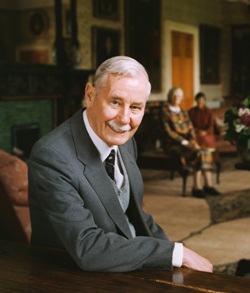Isles Strachan 1924-2012
 Distinguished graptolite palaeontologist at Birmingham University, who was also a talented mathematician and linguist.
Distinguished graptolite palaeontologist at Birmingham University, who was also a talented mathematician and linguist.
Isles was born at Loanhead, Edinburgh, on 12 March 1924. He attended the Royal High School, Edinburgh, where he was the Tullis Medal Dux in Mathematics for 1942. He went to Edinburgh University where he studied Geology, Botany, Zoology and Astronomy. His studies were interrupted due to a bout of ill-health, but in spite of this he was awarded the medal for Advanced Palaeontology in 1946 and graduated BSc Geology in December 1946. He moved on to Selwyn College, Cambridge, where he gained his PhD in 1951.
In the same year he was appointed to a Lectureship in Geology at Birmingham University where he spent the rest of his academic career, rising to Senior Lecturer. During his time there, he specialised in graptolites; their morphology and their use in stratigraphy. His diligent work was recognised with the naming of three graptolites after him: Huttagraptus praestrachani, Huttagraptus strachani and Streptograptus strachani. He made a big contribution with his two synoptic supplements to the Elles and Wood monographs on graptolites. In 1957 he spent a year in Illinois on a Fulbright Scholarship.
During his time at Birmingham he founded the Lapworth Museum, in honour of the pioneering geologist and former Professor of Geology at Birmingham, Charles Lapworth. He taught himself to read Russian and Chinese, and he attended the International Congress in Prague in August 1968 when the Russians invaded Czechoslovakia. He had always hoped to go to China but this never materialised. However, he did dine at the Chinese Embassy in London at the invitation of the Consul in recognition of the help he had given to Chinese students.
Isles retired to St Andrews with his family in 1984, because he wanted to live close to a university library where he could continue his studies. Given his expertise in palaeontology in general, and graptolites in particular, he was given an Honorary position at St. Andrews University, where he contributed to the teaching courses for Geology Honours students, offering lectures and practicals on graptolites. In later life he set himself the task of translating Robert Sibbald’s ‘Scotia Illustrata’ (1684) from Latin into English.
When the graptolite community was informed of his death, a number of responses were received. One in particular summed up Isles’ achievements. Chen Xu of Nanjing wrote “he was a good friend of our Chinese graptolite workers. We will remember his outstanding contribution to the fine structures of graptolites.” Another co-worker said ”Isles' Palaeontographical Society monographs continue to be extensively used by all graptolite workers all of whom owe him a considerable debt of gratitude for the huge amount of time and effort that went into their production.”
During his time in Birmingham, he attended Weoley Hill Church in Selly Oak. It was there he met and married Peggy Thompson. They had one daughter, Margaret Isles. Both survive him.
Richard A Batchelor (with contributions from Jan Zalasiewicz, David Loydell and Denis Bates)